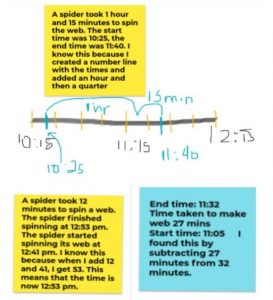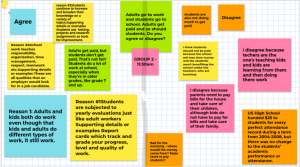KEEP CALM
AND
TEACH ONLine

ETFO’s position on in-person learning remains unchanged. The union firmly believes that the daily, in-person model of instruction and support best meets the educational, developmental and social needs of students, provides the best experience for support, and is the most equitable learning model for all students. ETFO’s expectation is that elementary virtual learning in any capacity, including through hybrid models of instruction, will end once the pandemic ends.
I’m in my third week of working to set up my online classroom and to get my students, and their parents, up to speed with learning critical online tasks. These include knowing how to log in, remembering passwords, and completing/submitting assigned work. In addition, all of us, students, parents, and teachers, are facing a steep learning curve with using applications and technology not previously implemented.
I’ll be honest with you, reader, I’ve had some lasting moments of being completely overwhelmed with the circumstances we are going through as teachers. Isolated in our homes, we deal with steep learning curves while worrying about our students in their lives and in their learning.
Due to the Covid-19 pandemic crisis, online learning has been very quickly implemented by asking teachers, who usually teach face to face, to move to an online format. Students, who usually learn face to face, are now having to negotiate online learning without the support of their teachers. Parents, who usually rely on teachers to do the work of education, are now having to take on this role.
Doing the work of education
Through an informal survey of 145 people, via Twitter, 64% of mothers were taking on most of the education work of teaching online, while only 8% of the fathers were taking on most of this work. In addition, the survey indicated that 28% of both parents shared this education work.
This is particularly challenging as mothers and grandmothers are having to manage and maintain households while they keep children occupied and prepare meals in addition to working online and helping their children do schoolwork online. In other words, as one parent stated, parents are acting as ad hoc Teaching Assistants.
Inequity and exclusion of access to technology and reliable internet
School boards are inadequately funded for having students work from home and only have limited resources to supply students with the technology they need to do this work. As a result, some students are doing their work on their parents’ phones. Adequate internet access is also a challenge in urban and rural areas. Students who live in low socioeconomic settings cannot afford technology to support online learning as it is an unaffordable luxury.
This discrepancy in access to technology has amplified the digital divide which boards of education and the Ontario Ministry of Education have known about for many years. Boards of Education have used stop gap measures such as students bringing devices to school which results in students using their phones to do schoolwork. Even with this measure in place, there are still students who’s families cannot afford any technology or internet access to support the technological needs of their classrooms.
In a classroom of students who “have” access to their own technology, the “have not” students stick out. This presents a significant inequity and exclusion from a society that relies on technology and internet every day. If this was not the case, the Ontario Ministry of Education could not have implemented provincial online learning from home for all Ontario students. The problem is that not all Ontario students are receiving the needed accommodations to support their learning.
When teaching is online, learning opportunities become visible. The Covid-19 pandemic crisis has not only made learning visible but has made the inequity in learning with technology visible. This crisis has highlighted the great divide in students’ access to technology and internet. Skills developed through using this technology are key to students’ futures in doing well in education and obtaining jobs that provide a living wage. Again, students without access to technology and reliable internet face inequity and exclusion in society.
Ontario’s Education Policy Memorandum No. 119 cites that all publically funded school boards are required to address Barriers to Learning through policies of equity and inclusion. In disregarding these barriers, human rights violations occur as cited in the Ontario’s Human Rights Code. These Barriers to Learning have always been there for students; now educators are facing the consequences of inequities and exclusion while teaching online.
Challenging times for educators for teaching online
As I teach teachers online and communicate with parents and teachers from my school, I’ve collected anecdotal notes on their experiences. In addition, I’ve talked to colleagues who are also sharing their challenges with online teaching and learning.
In total, I’ve collected feedback from teachers who are experiencing many challenges from a variety of school neighbourhoods. These include schools in First Nation communities, British schools, schools in Ontario and other Canadian provinces, schools in low socio-economic communities, and schools in areas with high levels of immigration. These teachers instruct students from kindergarten to grade 12. Below are some of the major issues that the teachers addressed:
Adequate internet access:
- In some rural and fly-in communities internet signals are not strong enough to have all students on the communities’ internet at the same time
- Even in urban areas internet can be inconsistently unreliable
- Many fly-in communities do not have basic services such as potable water thus making internet very much a luxury
- Underfunding of special education means inequity and exclusion in these areas for students who need technology to learn
- Some students have no access to internet or technology supports
Challenges teachers are facing in teaching online:
- supporting learning via emails/phone calls with parents
- listening to parental challenges with online learning
- getting students to complete assigned work
- dealing with only 20 to 70% of students signing into online courses
- dealing with students only submitting 0 to 50% of assigned work
- supporting parents with low levels of literacy
- supporting parents with low levels of English and/or French as their second/third language
Supporting Students with Special Education Needs
Students with special education needs are one of the groups of students who are not receiving the support they need in this challenging time. When not at school, these students miss out on their usual learning supports that includes therapy, counselling, equipment needed for learning, assisted behaviour modification, and trained educators who deal with specific student needs.
With everyday that passes, these students miss on the supports they need to be successful as learners. For these vulnerable students, every day that is missed results in one more day of a lost opportunity to learn.
Provincial Ministries of Education need to step up and provide emergency funding for technology supports which includes paid internet access and computers to implement online learning for all.
Lost opportunities in a time of inequity and exclusion
A teacher candidate, Ms. Randhawa wrote …
“The whole world is making the best use of technology for the first time and it is very much visible that learning is not just confined to classrooms anymore.”
Indeed, not only is learning more visible but so is the discrepancies between the families who have access to technology resources and those who do not.
Due to the Covid-19 pandemic, the digital divide, between the “have” and “have nots”, is in the front line of education for all the world to see. Provincial Ministries of Education must address this deficit so boards of education can support all students. Without this, Barriers to student learning for our most vulnerable students will be impacting children’s lives, today and tomorrow.
A note just for teachers: Please remember to put the oxygen mask on yourself first. Care for yourself so you can support your students. Without a well rested and healthy teacher to support learning, students, and their parents, will be on their own.
Collaboratively Yours,
Deb Weston, PhD – At Home, Teaching and Learning Online




